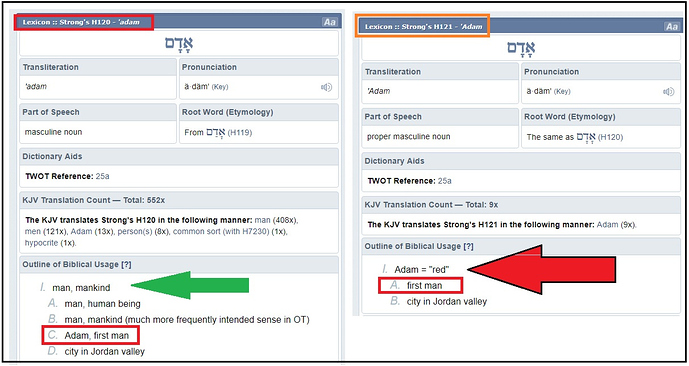I’m trying to understand the way Strong’s Concordance lists the references to ʾādām in the Old Testament. From what I’ve read, Strong’s normally has a separate entry (or “Strong’s number”) for each distinct word used in the Bible, regardless of how many discrete meanings that word has. But for ʾādām there are two entries, H120 and H121. It appears H120 is for the general meaning of humanity or any human while H121 is for when the word appears as a proper noun. But against this idea H121 doesn’t include Genesis 5:2 where Adam is given as a name.
I’m interested in this because the way Strong’s divides words has lasting significance. Since it’s widely used and in the public domain, its “Strong’s numbers” continue to be used by many current tools. Especially for non-experts, digging a bit into the Hebrew behind a verse of Scripture will usually lead to Strong’s numbers. The way Adam is divided often prevents the general meaning of the word (“humanity”) from appearing when one looks up Adam in the Bible.
So, my questions:
-
Is there an actual difference between the words Strong’s classifies as H120 and H121 that is visible in manuscripts (even if only later pointed ones)?
-
If not, is this a deviation from the usual way Strong’s records words, or are there certain kinds of words that are also split into two (or more) entries? (I’m aware that Baal/master is another word that seems to be split like this, but Satan/adversary isn’t, so I don’t see a fixed pattern at work.)
-
Some sources state that ʾādām means red or ruddy, and they do this in the context of speaking about the Adam named in Genesis. This seems to be based on the related word H119 that isn’t found in Genesis. Is this a distinct word from H120/H121?
-
Is the whole concept of a “distinct word” so fuzzy that one can’t really say whether Strong was right or wrong in how he split H119, H120 and H121?
Thanks to anyone who is able to help with this somewhat technical issue!


